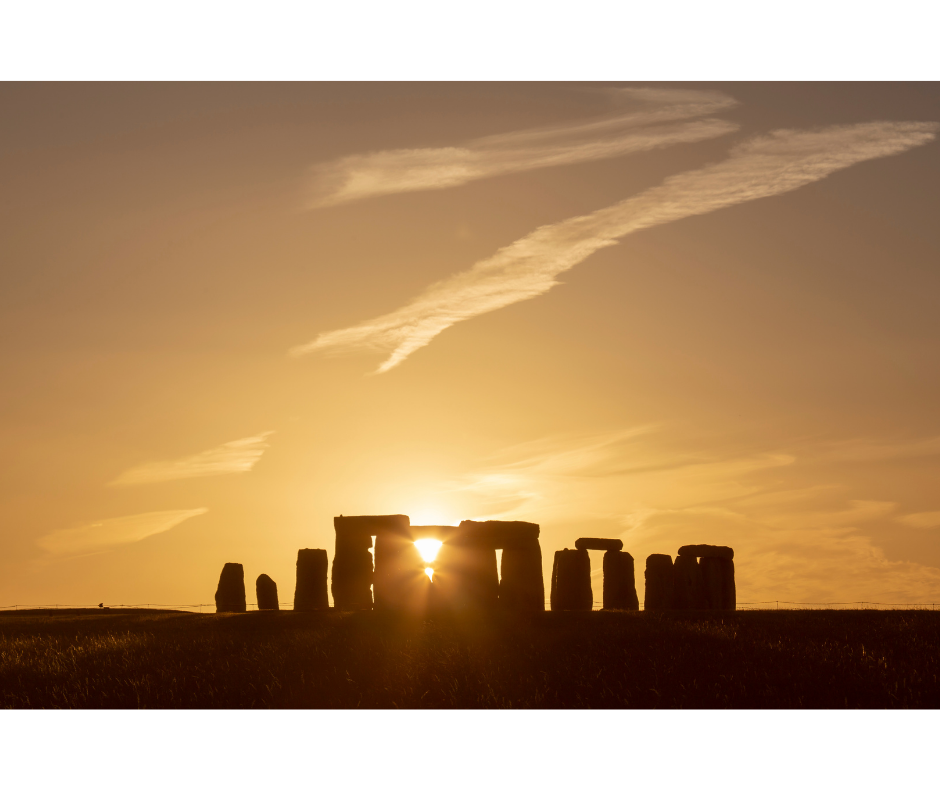Happy Summer! The Summer Solstice officially began, by NASA’s most scientific and accurate calculations, at 8:32 pm PDT on June 20 (Sunday night). This marks the longest day of the year in the Northern Hemisphere, the day when the sun’s path across the sky is the longest and when the sun reaches its highest point. Earth’s tilt on its axis means the North Pole is shifted almost entirely toward the sun, so the day is its extra longest–welcome to literally the longest Monday of the year.
If you are in mind of seasons and time and planets and stars and the cosmos, seems like the moment to share some titles you may want to check out with your library card to while away the hours today–while we’ve got all that natural reading light available! Here are some big histories: the beginning of the cosmos, humans, civilization: everything under that (high, hot) sun!
A Most Improbable Journey: A Big History of Our Planet and Ourselves by Walter Alvarez ©2017
Big History, the field that studies the entire known past of our universe to give context to human existence, has so far been the domain of historians. In A Most Improbable Journey, Walter Alvarez–best known for his “Impact Theory” explaining dinosaur extinction–makes a compelling case for a new, science-first approach to Big History. He brings a scientist’s view to the human story, from the creation of our universe and our planet, the rise of life, the movement of our continents and its effect on human migration, to humanity’s ascendance. Alvarez’s observations and stories will give readers a new appreciation of the events that have led to the human situation. Through entertaining, bite-sized chapters, A Most Improbable Journey will send readers out in a thousand directions to learn more.
Origin Story: A Big History of Everything by David Christian ©2018
Most historians study the smallest slivers of time, emphasizing specific dates, individuals, and documents. But what would it look like to study the whole of history, from the big bang through the present day — and even into the remote future? How would looking at the full span of time change the way we perceive the universe, the earth, and our very existence?
These were the questions David Christian set out to answer when he created the field of “Big History,” the most exciting new approach to understanding where we have been, where we are, and where we are going. In Origin Story, Christian takes readers on a wild ride through the entire 13.8 billion years we’ve come to know as “history.” By focusing on defining events (thresholds), major trends, and profound questions about our origins, Christian exposes the hidden threads that tie everything together — from the creation of the planet to the advent of agriculture, nuclear war, and beyond.
With stunning insights into the origin of the universe, the beginning of life, the emergence of humans, and what the future might bring, Origin Story boldly reframes our place in the cosmos.
Sapiens: A Brief History of Humankind by Yuval N Harari ©2015
From a renowned historian comes a groundbreaking narrative of humanity’s creation and evolution that explores the ways in which biology and history have defined us and enhanced our understanding of what it means to be “human.”
One hundred thousand years ago, at least six different species of humans inhabited Earth. Yet today there is only one–homo sapiens. What happened to the others? And what may happen to us?
Most books about the history of humanity pursue either a historical or a biological approach, but Dr. Yuval Noah Harari breaks the mold with this highly original book that begins about 70,000 years ago with the appearance of modern cognition. From examining the role evolving humans have played in the global ecosystem to charting the rise of empires, Sapiens integrates history and science to reconsider accepted narratives, connect past developments with contemporary concerns, and examine specific events within the context of larger ideas.
Dr. Harari also compels us to look ahead, because over the last few decades humans have begun to bend laws of natural selection that have governed life for the past four billion years. We are acquiring the ability to design not only the world around us, but also ourselves. Where is this leading us, and what do we want to become?
Featuring 27 photographs, 6 maps, and 25 illustrations/diagrams, this provocative and insightful work is sure to spark debate and is essential reading for aficionados of Jared Diamond, James Gleick, Matt Ridley, Robert Wright, and Sharon Moalem.
The Human Cosmos: Civilization and the Stars by Jo Marchant ©2020
For at least 20,000 years, we have led not just an earthly existence but a cosmic one. Celestial cycles drove every aspect of our daily lives. Our innate relationship with the stars shaped who we are–our art, religious beliefs, social status, scientific advances, and even our biology. But over the last few centuries we have separated ourselves from the universe that surrounds us. It’s a disconnect with a dire cost.
Our relationship to the stars and planets has moved from one of awe, wonder and superstition to one where technology is king–the cosmos is now explored through data on our screens, not by the naked eye observing the natural world. Indeed, in most countries modern light pollution obscures much of the night sky from view. Jo Marchant’s spellbinding parade of the ways different cultures celebrated the majesty and mysteries of the night sky is a journey to the most awe inspiring view you can ever see–looking up on a clear dark night. That experience and the thoughts it has engendered have radically shaped human civilization across millennia. The cosmos is the source of our greatest creativity in art, in science, in life.
To show us how, Jo Marchant takes us to the Hall of the Bulls in the caves at Lascaux in France, and to the summer solstice at a 5,000-year-old tomb at New Grange in Ireland. We discover Chumash cosmology and visit medieval monks grappling with the nature of time and Tahitian sailors navigating by the stars. We discover how light reveals the chemical composition of the sun, and we are with Einstein as he works out that space and time are one and the same. A four-billion-year-old meteor inspires a search for extraterrestrial life. The cosmically liberating, summary revelation is that star-gazing made us human.
The Upright Thinkers: The Human Journey From Living in Trees to Understanding the Cosmos by Leonard Mlodinow ©2015
A few million years ago, our ancestors came down from the trees and began to stand upright, freeing our hands to create tools and our minds to grapple with the world around us.
Leonard Mlodinow takes us on a passionate and inspiring tour through the exciting history of human progress and the key events in the development of science. In the process, he presents a fascinating new look at the unique characteristics of our species and our society that helped propel us from stone tools to written language and through the birth of chemistry, biology, and modern physics to today’s technological world.
Along the way he explores the cultural conditions that influenced scientific thought through the ages and the colorful personalities of some of the great philosophers, scientists, and thinkers: Galileo, who preferred painting and poetry to medicine and dropped out of university; Isaac Newton, who stuck needlelike bodkins into his eyes to better understand changes in light and col∨ and Antoine Lavoisier, who drank nothing but milk for two weeks to examine its effects on his body. Charles Darwin, Albert Einstein, Werner Heisenberg, and many lesser-known but equally brilliant minds also populate these pages, each of their stories showing how much of human achievement can be attributed to the stubborn pursuit of simple questions (why? how?), bravely asked.
The Upright Thinkers is a book for science lovers and for anyone interested in creative thinking and in our ongoing quest to understand our world. At once deeply informed, accessible, and infused with the author’s trademark wit, this insightful work is a stunning tribute to humanity’s intellectual curiosity.
A Brief History of Time directed by Errol Morris ©2014
Errol Morris (The Fog of War) turns his camera on one of the most fascinating men in the world: the pioneering astrophysicist Stephen Hawking, afflicted by a debilitating motor neuron disease that has left him without a voice or the use of his limbs. An adroitly crafted tale of personal adversity, professional triumph, and cosmological inquiry, Morris’s documentary examines the way the collapse of Hawking’s body has been accompanied by the untrammeled broadening of his imagination.
Mapping the Heavens: The Radical Scientific Ideas that Reveal the Cosmos by Priyamvada Natarajan ©2016
This book provides a tour of the “greatest hits” of cosmological discoveries–the ideas that reshaped our universe over the past century. The cosmos, once understood as a stagnant place, filled with the ordinary, is now a universe that is expanding at an accelerating pace, propelled by dark energy and structured by dark matter. Priyamvada Natarajan, our guide to these ideas, is someone at the forefront of the research–an astrophysicist who literally creates maps of invisible matter in the universe. She not only explains for a wide audience the science behind these essential ideas but also provides an understanding of how radical scientific theories gain acceptance.
The formation and growth of black holes, dark matter halos, the accelerating expansion of the universe, the echo of the big bang, the discovery of exoplanets, and the possibility of other universes–these are some of the puzzling cosmological topics of the early twenty-first century. Natarajan discusses why the acceptance of new ideas about the universe and our place in it has never been linear and always contested even within the scientific community. And she affirms that, shifting and incomplete as science always must be, it offers the best path we have toward making sense of our wondrous, mysterious universe.

